![]()
![]()
![]()
Use LEFT and RIGHT arrow keys to navigate between flashcards;
Use UP and DOWN arrow keys to flip the card;
H to show hint;
A reads text to speech;
61 Cards in this Set
- Front
- Back
|
Living Things Use ATP to... (6 functions)
|
1: Maintain homeostatic balance
2: Detect and respond (nervous) to stimuli 3: Reproduce (sexual and asexual reproduction) 4: Synthesise tissue 5: Contract muscles (movement) 6: Prime catabolic pathways |
|
|
3 Types of Carbohydrates (give examples of each)
|
Monosaccharides (sugars) - e.g. glucose
Disaccharides (complex sugars) - e.g. sucrose Polysaccharides (starches and fibres) - e.g. amylose |
|
|
Draw and Describe a Diagram of Villi and Micro-villi
|
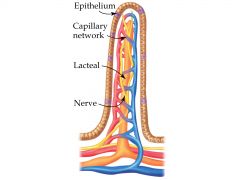
Villi massively increase the surface area of the small intestine. The lacteal specifically absorbs lipids.
|
|
|
Draw a Diagram of the Circulatory System
|
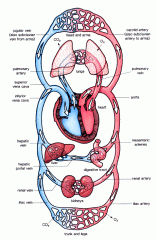
|
|

Label the Diagram of the Digestive System
|
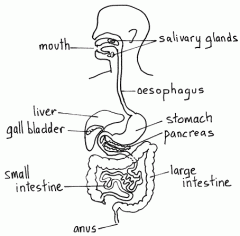
|
|
|
Draw a Diagram of the Kidney
|
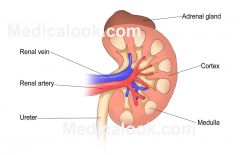
|
|
|
Draw the Structure of the Nephron
|
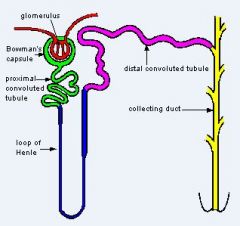
|
|
|
Draw a Diagram of the Respiratory System
|
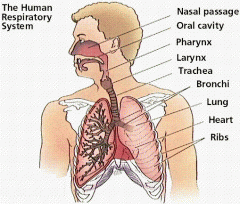
|
|
|
Draw a Diagram of Alveoli
|
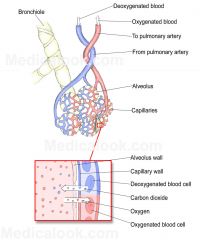
|
|
|
Homeostasis
|
The maintenance of a constant internal environment mediated by negative feedback systems
|
|
|
Nutrient
|
Nutrients, taken from food, supply energy (ATP) to the body, as well as contributing to the building blocks (carbohydrates, proteins, lipids, vitamins, mineral etc.) of the body.
|
|
|
Glucagon
|
A hormone released by the pancreas which stimulates the conversion of glycogen to glucose.
|
|
|
Define Enzyme
|
An organic catalyst, produced by living cells, that lowers the activation energy required for a chemical reaction to take place; thereby increasing the rate of a chemical reaction.
|
|
|
ATP
|
Adenosine Tri-Phosphate
|
|
|
Cellular Respiration Equation
|
C6H12O6 + 6O2 --> 6H2O + 6CO2
|
|
|
3 Processes of Cellular Respiration
|
1: GLYCOLYSIS - break down of glucose (anaerobic), occurs in the cytoplasm; generates 2 ATP.
2: THE KREBS CYCLE - releases electrons (aerobic), occurs in the mitochondria; generates 2 ATP. 3: THE ELECTRON TRANSPORT CHAIN - converts electrons to energy (aerobic), occurs in the mitochondria; generates 24 ATP |
|
|
Purpose of Digestive System
|
To break down large, insoluble molecules into small, soluble molecules capable of passing through cell membranes, thus providing essential nutrients to the body.
|
|
|
Alimentary Canal
|
The mouth, oesophagus, stomach, small intestine, large intestine, rectum and anus.
|
|
|
Define Carbohydrate (and give the general formula)
|
A component of food that supplies energy (kJ/g) to the body. Is one of the three macronutrients (along with proteins and lipids)
The general formula of a carbohydrate is CH2O, thus, glucose has the formula (CH2O)6 = C6H12O6 |
|
|
Functions of Carbohydrates (2ii)
|
1: Carbohydrates are important energy sources that can be used in respiration as monomers or stored as polymers like starch and glycogen.
2: They also have structural uses such as cellulose in plant cell walls and chitin in fungi and arthropods. |
|
|
Define Metabolism
|
The metabolic rate is the sum of catabolic and anabolic processes.
|
|
|
Define Catabolic Processes (give an example)
|
Catabolic processes derive ATP - e.g. cellular respiration
|
|
|
Define Anabolic Processes (give an example
|
Anabolic processes require ATP - e.g. synthesis reactions
|
|
|
Functions of Lipids (3)
|
1: Protection - mechanical and thermal
2: Energy storage (6 x kJ/g of carbohydrates) 3: Structural - membranes |
|
|
Structure of Lipids
|
Triglycerides are made up of three fatty acids bonded with a glycerol molecule. The longer the carbon chains in the fatty acids, the less volatile the molecule is.
|
|
|
Digestion: Mouth
|
PHYSICAL DIGESTION:
* Teeth - cut food into smaller pieces * Saliva - lubricates food, enabling it to pass easily through the oesophagus CHEMICAL DIGESTION: * Saliva - contains amylase, an enzyme that breaks down amylose (complex carbohydrate) |
|
|
Digestion: Oesophagus
|
PHYSICAL DIGESTION:
* Peristalsis - transports food from the mouth to the stomach |
|
|
Digestion: Stomach
|
CHEMICAL DIGESTION:
* HCl and enzymes (protease and amylase) - breaks down proteins and carbohydrates * HCl - kills some bacteria |
|
|
Digestion: Liver
|
CHEMICAL DIGESTION:
* Produces Bile - emulsifies fat |
|
|
Digestion: Gall Bladder
|
CHEMICAL DIGESTION:
* Stores Bile - emulsifies fat |
|
|
Bile
|
Emulsifies lipids from food for easy digestion and absorption (allows lipids to be mixed with water)
|
|
|
Digestion: Pancreas
|
CHEMICAL DIGESTION:
* Produces Pancreatic Juices into the Duodenum Via the Pancreatic Duct - contains enzymes to digest carbohydrates, proteins and lipids as well as sodium bicarbonate to neutralise the chyme from the stomach. |
|
|
What is the Function of Amylase?
|
Breaks complex carbohydrates down to monosaccharides.
|
|
|
What is the Function of Protease
|
Breaks protein down to peptides and then amino acids.
|
|
|
What is the Function of Lipase
|
Breaks lipids down to fatty acids and glycerol.
|
|
|
What is the Function of Nuclease?
|
Breaks nucleic acids down to nucleotides.
|
|
|
Digestion: Small Intestine
|
PHYSICAL DIGESTION:
* Villi - significantly increase the surface area of the small intestine to increase absorption CHEMICAL DIGESTION: * Villi - nutrients are absorbed through the lining if the small intestine (mostly made up of villi and micro-villi) and transferred to the bloodstream. |
|
|
Digestion: Large Intestine
|
CHEMICAL DIGESTION:
* Colon - absorbs water and electrolytes from the small intestine |
|
|
Digestion: Rectum
|
PHYSICAL DIGESTION:
* Stores solid waste until it leaves the body through the anus |
|
|
What is the Purpose of the Kidney?
|
The kidney is an excretory organ that filters wastes, mainly nitrogenous, from the blood and forms urine.
|
|
|
ADH
|
Anti-Diuretic Hormone
* Regulates water balance * Prevents the release of water through urination |
|
|
Define Anaerobic Processes
|
Anaerobic processes do not require oxygen.
|
|
|
Define Aerobic Processes
|
Aerobic processes require oxygen.
|
|
|
Functions of Proteins (7)
|
1: Immunoglobulin (immune system)
2: Structural (collagen) 3: Muscular Contraction 4: Toxins (venomous animals) 5: Enzymes 6: ATP Generation(electron transport chain) 7: Nerve Transmission (active transport) |
|
|
Describe the Relationship Between Dependant and Independent Variables
|
The dependant variable changes as you change the independent variable.
|
|
|
The Circulatory System is Composed Of... (3)
|
* Capillaries, arteries and veins
* Heart * Blood |
|
|
Describe the Aorta
|
The aorta transports oxygenated, nutrient-rich blood to the whole body.
|
|
|
Describe the Blood Travelling Through the Superior Vena Cava
|
Deoxygenated and low in nutrients
|
|
|
Describe the Blood Travelling Through the Aorta
|
Oxygenated and high in nutrients
|
|
|
Describe the Blood Travelling Through the Pulmonary Artery
|
Deoxygenated and high in nutrients
|
|
|
Describe the Blood Travelling Through the Pulmonary Vein
|
Oxygenated and high in nutrients
|
|
|
Describe the Blood in the Right Atrium
|
Deoxygenated and low in nutrients
|
|
|
Describe the Blood in the Left Ventricle
|
Oxygenated and high in nutrients
|
|
|
What are the Functions of Blood? (2iv)
|
*Regulates body temperature
*Transports hormones, nutrients, oxygen and metabolic waste around the body |
|
|
What is Blood Composed of? (3)
|
Plasma - Thromobocytes (blood clotting)
Platelets Red Blood Cells - Erythrocytes (transportation of oxygen) White Blood Cells - Leukocytes (immune system response) |
|
|
Functions of the Liver (3)
|
* Purification and detoxification of blood
* Helps in the maintenance of blood glucose levels (storage of glucose as glycogen) * Production of bile |
|
|
Describe the Enzyme-Sybstrate Complex
|
Enzymes act only upon a specific substrate. Some enzymes are more specific than others
|
|
|
Describe the Induced Fit Theory
|
The shape of the enzyme's active site is modified to accommodate the substrate.
|
|
|
Describe the Lock and Key Theory
|
An enzyme's function depends on its shape.
|
|
|
Describe Diffusion in the Alveoli
|
Due to its high concentration in the air in the alveoli, oxygen diffuses across the membrane to the capillaries surrounding each alveolus. The high concentration of metabolic waste in the blood causes it to diffuse into the alveoli; therefore, we breathe carbon dioxide and water vapour out.
|
|
|
Explain the Transport of Air Through to the Alveoli
|
Air enters through the nasal cavity and mouth and travels through the pharynx, larynx, trachea and bronchi before entering an alveolus.
|

